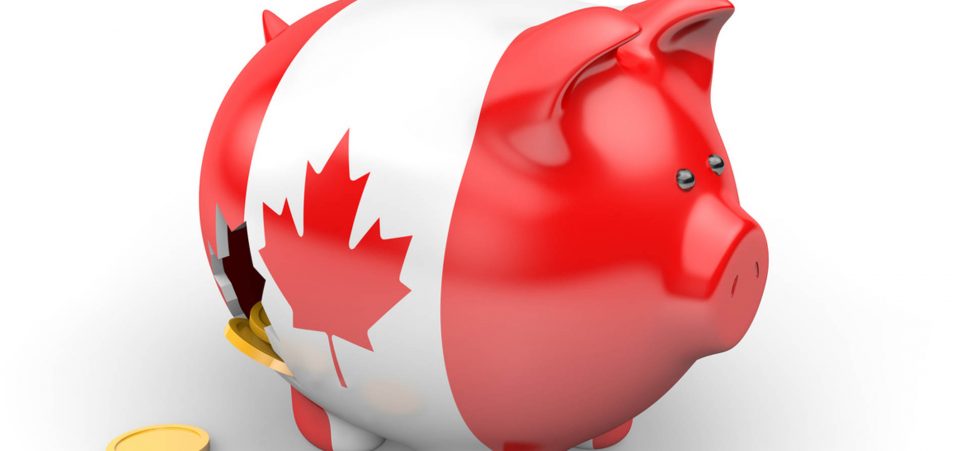Canadian Economy Dives
Despite the rosy year-end optimism from Justin Trudeau, Canada’s doe-eyed Prime Minister, the Canadian economy is tanking. This comes at a time when Canadians are taking on record amounts of debt and the jobless rate is continuing to hover around seven percent. This does not bode well for our neighbors to the north with visions of a recession in 2017 coming into focus.
Canada’s monthly gross domestic product (GDP) continues its roller coaster ride of unpredictability. After four months of modest growth, the Canadian economy contracted to -0.3% month-over-month in October. Analysts were expecting GDP to come in at a robust zero. Since the start of the year, Canada’s GDP has contracted four times. (Source: “Gross domestic product by industry, October 2016,” Statistics Canada, December 23, 2016.)
The decline was broad-based, too, suggesting that the country’s economic ills are not limited to the oil and gas sector. Activity declined in 13 of the 20 economic sectors tracked by StatsCan. The mining, oil, and gas sector decreased by 1.2% in October. Conventional oil and gas was down 2.9%, while non-conventional oil extraction was down two percent.
The economy-churning construction sector fell -0.5% in October, the fifth decline in six months with residential construction down -1.0%. The repair and non-residential construction sector was also down.
Just like in the U.S., the demand for waiters and waitresses is up in Canada. Retail trade increased 0.7% month-over-month with the biggest gains in food and beverage and department stores. This helped Canada’s jobless rate dip to 6.8% in November. Sadly, many new jobs were part time, and youth unemployment in Canada remains near 13%! (Source: “Labour force survey,” Statistics Canada, December 2, 2016.)
It wasn’t all good news for the consumer-driven economy; there were declines in health and personal care stores, gas stations, and electronics and appliance stores.
Because we’re talking about Canada, and Justin Trudeau hasn’t met a tax dollar he doesn’t like to spend, jobs in the bloated public sector (education, health and public administration) inched up 0.1%.
This may not sound like a lot, but when the rest of the economy is suffering, it’s an additional tax burden on the already strained private sector. If you want a job in Canada, there’s nothing like the public sector; employees earn more, have a better pension, and retire earlier than those in the income-generating private sector.
Will Canada Tumble into a Recession in 2017?
Suffice it to say, Canada’s inconsistent GDP data underscore the growing bearish sentiment. Further, the country’s weak job market does not exactly reflect an uptick in business confidence or sustained economic growth.
Thanks to anemic GDP growth and record high consumer debt levels, it is widely expected that the Bank of Canada will cut interest rates again in the first half of 2017. This runs counter to what is happening in the U.S., where the economy, while fragile, is nowhere near the state of the Canadian economy.
In fact, the Bank of Canada recently released a video where it explains different ways in which the Canadian economy could implode. The two biggest triggers are high household debt and the housing bubble. (Source: “The Risk of Household Financial Stress and a Sharp Correction in House Prices,” Bank of Canada, December 19, 2016.)
Canadian household debt hit record levels in the third quarter, as Canada’s love of artificially low interest rates fueled heavy borrowing. The ratio of disposable income climbed to 166.9% in the third quarter from a revised 166.4% in the second quarter. That means Canadian households owe $1.67 for every dollar of disposable income. (Source: “National Balance Sheet and Financial Flow Accounts, Third Quarter 2016,” Statistics Canada, December 14, 2016.)
To put that into context, when adjusted for inflation, Canada’s household debt to GDP ratio (at 165.2%) is just 0.6% shy of the 2007 peak in the U.S. (165.8%).
Real estate (selling, managing, renting, and leasing) is the largest segment of the Canadian economy, accounting for 13% of GDP. In 2015, real estate was the largest contributor to GDP in seven of 10 provinces.
Toronto, the country’s largest city, is also the least affordable. In November, the average selling price for all homes was up an eye-watering 22.7% year-over-year at $776,684. The average selling price for a detached home in Toronto is $1.35 million. (Source: “GTA Realtors Release Monthly Resale Housing Market Figures,” Toronto Real Estate Board, December 2, 2016.)
While Canadians can cope with these vulnerabilities for a period of time, the cracks could split if the country enters a recession. A recession would lead to a big increase in unemployment, which, as we saw in the U.S. during the Great Recession, would cobble households burdened by big debt loads. Canadian households would start to default on their loan and banks would foreclose on their properties.
Knee deep in a recession, first-time home buyers would delay home purchases until the economy improves. This could end up putting a chill on the housing market and property prices.
If housing prices fall, household wealth would shrink, which would put a serious damper on consumer spending.
Will a recession trigger a collapse in the Canadian economy? A Canadian recession in 2017 is open for debate. What isn’t is the impact the collapse in real estate has on the economy. For an example, see the U.S. housing bubble and the Great Recession.






